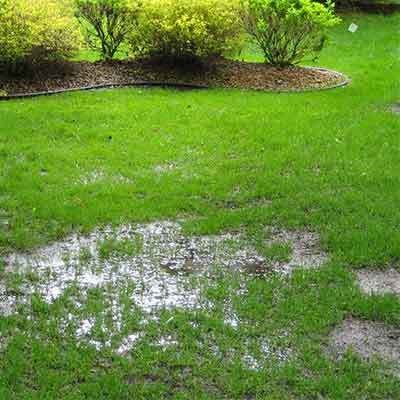Improving Drainage Protects and Enhances Property
Southern Wisconsin has had more than its share of rain early in 2018 and with the downpours come concerns for improving drainage. Standing water in the yard after normal rainfall is a sign the “playing field” isn’t level. A variety of landscaping solutions can be applied to make sure excess water moves away from buildings and structures, avoiding damage to your Madison WI home.
It’s easier to spot a problem than to remedy it. When water collects in the same spot time after time, you know that area isn’t level. If a deluge overwhelms gutters and water collects at your home’s foundation, you know the slope away from the house isn’t right. Improving drainage around the house and yard takes attention to detail, experience and the right tools.
Improving Drainage Requires Data
Once you identify the problem areas – where ducks swim in your backyard after a rain! – you can begin to collect information telling you why water moves to that spot. Here are considerations to examine to evaluate the situation and suggest appropriate landscaping solutions:
Existing Drainage – to work on a solution you need to know what’s happening now. Dig a hole (2 feet wide and 2 feet deep is a good starter) and fill it to the top with water. Time how long it takes to empty. The longer it takes the poorer the drainage through the soil. When it takes a long time to empty the flow of water can have an impact on all the plants, especially those with deep root zones like trees and shrubs.
Surface Preparation – in theory, residential lots are graded to allow water to move out of the backyard and toward the curb or some other drain systems. In reality, developers don’t always get the grade right, houses aren’t always backfilled properly and additions to the property can change the natural flow of water.
TIP FROM A PRO — DIY projects in the backyard are inviting but there are little things that professionals are aware of that many amateurs are not. Installing a paver patio, deck, walkway or fire pit may look easy but even the simplest project can affect drainage – consider the soil compaction from machines and materials during the project for starters.
What Lies Beneath – when soil is compacted from repeated travel over it by heavy loads and heavy equipment – things like earth movers when the site was developed, cement trucks pouring foundations and construction tools putting in walls or structures – the soil becomes packed down. A layer known as “hardpan” can be created. This layer blocks water from permeating the ground and causes it to just sit in place or move laterally. Improving drainage in this situation requires installing drains or breaking up the hardpan.
High Water Table – in some areas the water held in the ground is so close to the surface that heavy rain has nowhere to go. Most common in low lying areas, it can be a real challenge to find landscaping solutions for these spots – the concept of the “rain garden” grew out of a need to find plants that can cope with regularly “wet feet.”
Taking On Standing Water
Not only is standing water ugly and harmful to landscape structures and landscape plants, left too long it is a health hazard. Puddles and pools that linger are breeding areas for mosquitoes and other pests. Landscaping solutions that can reduce the chances of standing water in your yard include:
Creating a positive flow of water away from your foundation by making sure all soil, mulch, gravel and plantings are well away from the building. Nothing makes contact with siding, and all around the house the ground slopes away from the building.
When planning landscape projects make certain drainage routes aren’t disrupted by berms, raised beds, play areas or structures.
When it doubt, extend downspouts further away from the foundation and well beyond planting beds. Provide tile or stone at the outflow to minimize erosion.
Keep gutters and downspouts clean and clear so water doesn’t have a chance to collect under the eaves – a Madison WI downpour can easily overwhelm gutters or downspouts filled with debris from last season or a previous storm.
Make sure your sump pump is working properly and that its discharge pipe directs water well away from the house.
Be certain the hard surfaces – porches, stoops, walks, driveways, patios – direct water away from structures. This is one of the most common problems resulting from installations by amateurs.
Consult with a professional landscaper with the right equipment for improving drainage and the experience to provide the right landscaping solutions.
TIP FROM A PRO — Before taking on any yard drainage project be sure to check the building code requirements. The county and individual municipalities may have building codes that restrict how and where storm water runoff can be discharged.
The slope away from your home is recommended to be at least a 2% grade. That isn’t much, but anything less than that can result in standing water or worse, water flowing toward your foundation and possibly into your basement. Even seemingly small things like ant hills, tufts of decorative grasses, ice and snow can block the flow of water if the slope isn’t right. Taking time to evaluate landscaping solutions for improving drainage is a wise investment.
Professionals Create Great Spaces
To extend the capacity for fun in your yard, call Proscapes LLC today and review what it takes to have a great outdoor living space. Proscapes LLC creates and maintains outdoor living spaces in Madison WI and throughout South Central Wisconsin.
Contact us at (608) 244-6464 or email us for a professional’s approach to landscape solutions and tips for improving drainage around your Madison WI home.
About the Author
With over two decades in business and maintaining an A+ rating by the Better Business Bureau the entire time, Proscapes LLC is a leading landscape company in the Madison, WI, area. As a Unilock Authorized Contractor, we are recognized as the best-of-the-best in our craft—earning numerous awards along the way.

